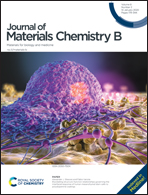Recent advances in cancer bioimaging using a rationally designed Raman reporter in combination with plasmonic gold
Abstract
We provide an updated overview of gold nanomaterials (AuNMs) widely used in bioimaging in combination with various kinds of Raman spectral markers mainly in cancer cells and tumours. Assisted by the plasmonic properties of AuNMs, enhanced Raman spectroscopy in aqueous samples has recently emerged as a versatile analytical technique, widely used for the determination and recognition of sensitive and selective information on a molecular complex in a physiological environment. The intensified vibrational spectra of a molecule that occur on the surfaces of AuNMs are often referred to as either “Raman spectral markers” or “fingerprints” of molecular species, probes, and labels. This review evaluates the kinds and specific features of AuNMs and Raman reporter molecules utilized in cancer bioimaging. These include the recent development of various size- and shape-controlled AuNMs for the optimization of plasmonic properties in combination with Raman spectral markers. Another section covers organic Raman dyes for bioimaging of cancer cells. The final part covers the aspects of the current challenges and perspectives on AuNM-based multimodal bioimaging, drug delivery-related biomonitoring, and cancer diagnosis. One of the main purposes is to develop rationally designed Raman dyes for cancer cell imaging.

- This article is part of the themed collection: Journal of Materials Chemistry B Recent Review Articles


 Please wait while we load your content...
Please wait while we load your content...